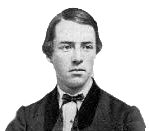Thursday, October 17. — We passed the Capes about 10 A.M., running within two miles and a half of Cape Henry. This cape is composed of sand-hills shelving down to the beach, with nothing but a lighthouse and two small houses to be seen anywhere in the vicinity. The point is in possession of the rebels. We passed the gunboat Daylight keeping the blockade, and guarding the lightship. We saw a great many duck flying about us. About 12 we came in sight of the Rip Raps, and soon after of Fortress Monroe. The Rip Raps, a few miles off, look like a mass of stones dumped down in a heap, and on coming nearer to them, one finds that the opinion he formed of them at first sight was correct. They embrace perhaps an acre and a half to two acres, and are formed entirely of granite rocks dropped in utter disorder and confusion into the middle of Hampton Roads, and at about a mile and a half from Fortress Monroe. There are one or two small houses on it for laborers, but a more desolate hole I cannot imagine. The fortress itself cannot be seen until you are quite near it, on account of the shore being so low. We could see only two sides of it from the sea, the houses and trees on the shore hiding the rest of it. I saw the famous Sewall’s Point for the first time. The batteries are not visible, being on the other side of the point. The masts of our ships at Newport News could also be seen, some 8 miles distant. We left our ship, the Ocean Express, here, and turned round and started for Annapolis, where we were to take our troops on board. We steamed up the Chesapeake to within about 40 miles of Annapolis, and then anchored on account of the fog. We passed the mouth of the Potomac, and also those celebrated Points —
P’int Lookout, and P’int Lookin,
P’int no p’int, and p’int agin.



